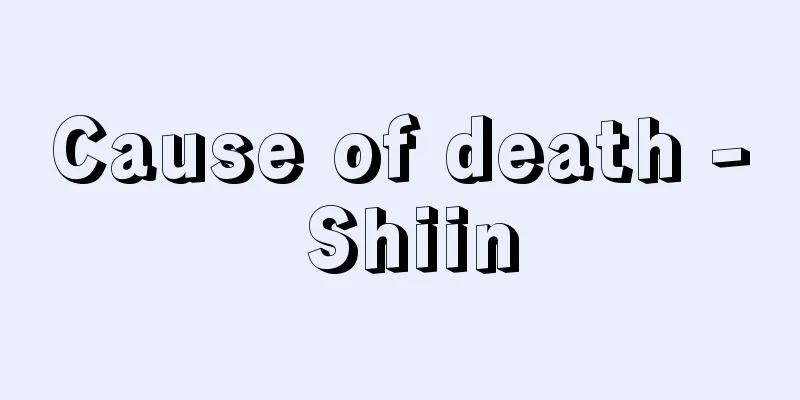Cause of death - Shiin

|
When the brain, circulatory, and respiratory functions necessary for life are completely and irreversibly stopped, the name of the injury or syndrome that caused it is called the cause of death, or the cause of death. The cause of death can be complex when there are multiple injuries or diseases, when injuries and diseases are combined, or when two or more medicines are used that together cause toxic shock. In 1967, the World Health Organization (WHO) defined the cause of death on the death certificate as "all diseases, pathological conditions, or injuries that caused or contributed to death, and the accidental or violent circumstances which caused these injuries." This is intended to ensure that all factors involved in the death are recorded on the death certificate. Causes of death that are directly related to the death are called direct causes of death, and physical conditions (comorbidities, chronic illnesses, etc.) that are thought to have influenced the death are called indirect causes of death. Death certificates and autopsy reports, as stipulated by the current Medical Practitioners Act Enforcement Regulations, require the direct cause of death to be written first, followed by causes of death that are thought to have been medically related. The names of injuries and illnesses used as causes of death are those commonly used in the medical community in Japan, and do not include symptoms that are commonly seen at the time of death, such as cardiac arrest or weakness. In the field of forensic medicine, when there are multiple injuries or lesions that could be the sole cause of death, the causes of death are said to be "competitive." In this case, the injury or lesion with priority is determined to be the cause of death, but if there are multiple perpetrators, the important issue is what responsibility each individual takes for the death. Clarifying the cause of death from disease is important in terms of discovering and improving the nature of the disease and methods of treatment, and in the case of unnatural deaths other than disease (injury, poisoning, asphyxiation such as hanging or strangulation, etc.), the cause of death is important information in determining who is responsible. In Japan, tuberculosis was one of the leading causes of death for a long time, but in recent years it has been followed by malignant neoplasms, cerebrovascular disease, and heart disease. Mortality statistics are compiled based on the injury or disease that was the starting point in terms of the progression of the injury or disease (original cause of death). [Akiko Sawaguchi] Source: Shogakukan Encyclopedia Nipponica About Encyclopedia Nipponica Information | Legend |
|
生命維持に必要な脳、循環、および呼吸の諸機能が全面的に不可逆的停止をきたすとき、その原因となった傷病名や症候群名を死因とよび、死亡原因ともいう。複数の損傷または疾病があったり、損傷と疾病が組み合わされたり、二つ以上の医薬品が用いられて、ともに薬物ショックをおこす誘因となる場合などでは、死因は複雑となる。1967年、世界保健機関(WHO)では、死亡診断書に記載される死因とは、「死亡を引き起こし、またはその一因となったすべての疾病、病態、もしくは損傷、およびこれらの損傷を引き起こした事故、もしくは暴力の状況」と定義している。これは、死亡に関与したすべての事項を死亡診断書に記載することを目的としたものである。 死亡に直接関係した死因を直接死因、死亡に影響を及ぼしたと思われる身体状況(併存症、持病など)を間接死因とよぶ。現行の医師法施行規則で定められた死亡診断書、および死体検案書では、直接の死因を第一に、次に医学的に因果関係のあったと考えられる死因を書くことが要請されている。死因としての傷病名は、わが国の医学界で通常用いられている傷病名を用い、心臓麻痺(まひ)や衰弱のような、死亡時に一般的に共通する症状名は含まない。法医学領域では、複数の損傷あるいは病変があり、これらが単独で死因となりうるとき、死因は「競合関係にある」という。この場合、優先性をもつ損傷や病変が死因と決定されるが、加害者が複数である場合は、死に対して各個人がいかなる責任をとるかが重要な問題となる。病死の死因を明らかにすることは、病気の性質、治療方法の発見・改良のうえからたいせつであり、病死以外の不自然死(傷害、中毒、縊頸(いけい)や絞頸などの窒息、その他)にあっては、その責任の所在の究明に向けての資料として、死因が重要なものとなる。日本では結核が長らく死因の上位を占めていたが、最近は悪性新生物、脳血管疾患、心疾患の順位である。なお死亡統計では、傷病の経過からみて出発点となった傷病(原死因)で統計をとることになっている。 [澤口彰子] 出典 小学館 日本大百科全書(ニッポニカ)日本大百科全書(ニッポニカ)について 情報 | 凡例 |
Recommend
Yamanobe no michi - Yamanobe no michi
This 35-kilometer road runs north to south, sligh...
blanket bog
...In the ponds that form in high moors, floating...
Love of Matačić - Love of Matačić
A conductor from the former Yugoslavia. Born in C...
Celtic art
Celtic art from the 6th century BC to the 3rd cent...
Tenjinzai and Kunitsuzumi - Amatsutsumi and Kunitsuzumi
A general term for crimes and disasters that were ...
bath-tub curve
...For example, if 100 products are used for a ye...
Kamigo Village
...A city located in the Tono Basin in the center...
Gangnam - Kounan
[1] ("江" means river) South of the river...
Yellow hawk
… In autumn, wild adult birds are lured in and ca...
Ukyo Chodai - Ukyo Chodai
...The only historical example is when Omi Shugo ...
Kawakami Bizan
Novelist. Born in Osaka. Real name Akira. Dropped...
Minh Mang (English spelling)
1791‐1841 The second emperor of the Nguyen Dynasty...
Paul Ehrlich
German bacteriologist and pioneer of chemotherapy...
Emperor Huizong
The 8th emperor of the Northern Song Dynasty (rei...
Heterogeneous body parts - Ikitisetsu
〘noun〙 A body segment in which each segment of the...









